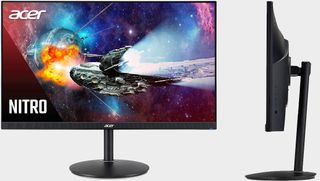Acer claims its new gaming monitors can achieve up to a 0.2ms response time
Kicking things into "overdrive."

Acer seems to be on a mission to virtually eliminate response times on gaming monitors. Following last week's announcement of its Predator XN253Q X, which sports an "overdrive mode" to drop the native 1ms response time to just 0.4ms, Acer today unveiled its Nitro XF2 series, and they go ever even lower with this mysterious mode.
There are two new models, the 27-inch Nitro XF272 X and 25-inch Nitro XF252Q. Both are Full HD 1080p displays with an ultra-fast 240Hz refresh rate, and both have a native 3ms response time. However, the 25-inch model can 'overdrive' to 0.3ms and the 27-inch model can achieve an astonishing 0.2ms.
These are both listed as GTG (gray-to-gray) response times, which is a common metric in the monitor space. What exactly does that mean, though? Our friends at Toms Hardware have a gamer's guide to refresh rates and response times, but in short, the response time is how long it takes a pixel to change colors.
Up until somewhat recently, the fastest advertised response times have been 1ms or higher. However, some monitor makers have touted sub-1ms displays, based on MPRT (motion picture response time).
According to Blur Busters, low MPRTs are only possible with a strobing backlight. Things get complicated when diving into these measurements, but this essentially reduces the perception of motion blur, rather than being a true native refresh rate.
When Acer announced its Predator XN253Q X monitor last week, I noticed that the press release referenced something called VRB (visual response boost) in the fine print. When I inquired about this, I was told it was a mistake, and that it should have said GTG.
Since then, I've been trying to get clarification from Acer on how exactly it is able to overdrive a GTG response time to below 1ms. I've yet to get an explanation. This time around, the press release for the Nitro XF2 models make a point to say "GTG" next to the claimed 0.2ms and 0.3ms response times. My hunch (unconfirmed) is that these monitors are utilizing backlight flickering when put into overdrive mode, but either way, these are impressive ratings.
The biggest gaming news, reviews and hardware deals
Keep up to date with the most important stories and the best deals, as picked by the PC Gamer team.
As for the other specs, both monitors are rated at 400 nits brightness with a 100,000,000:1 maximum contrast ratio, they support HDR10 content, and are FreeSync displays.
Other amenities include a pair of built-in 2W speakers and two USB 3.0 ports. Display inputs consist of HDMI and DisplayPort connectors.
The 25-inch version is available now for $349.99, and the 27-inch model will arrive later this month for $449.99.
Paul has been playing PC games and raking his knuckles on computer hardware since the Commodore 64. He does not have any tattoos, but thinks it would be cool to get one that reads LOAD"*",8,1. In his off time, he rides motorcycles and wrestles alligators (only one of those is true).
Most Popular






